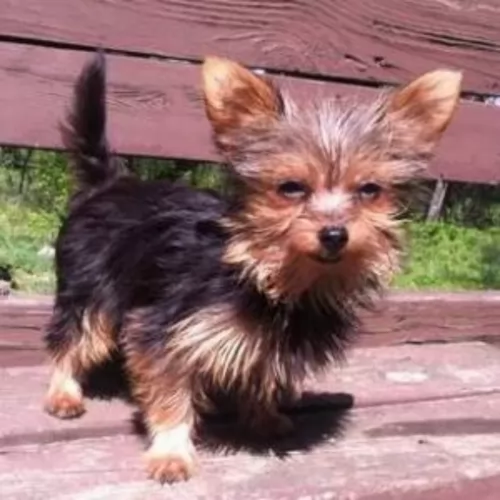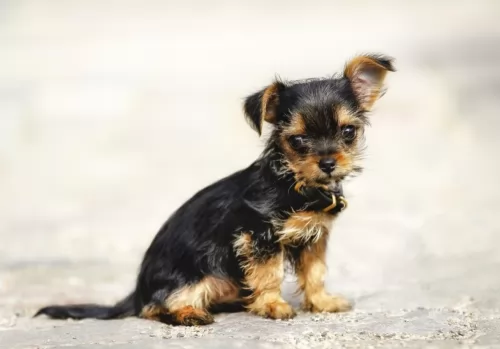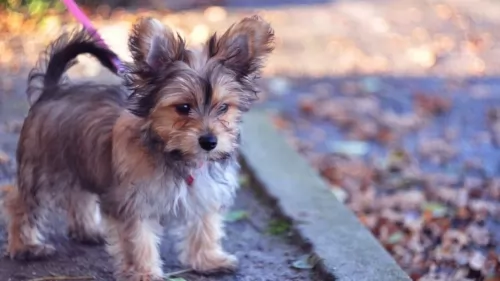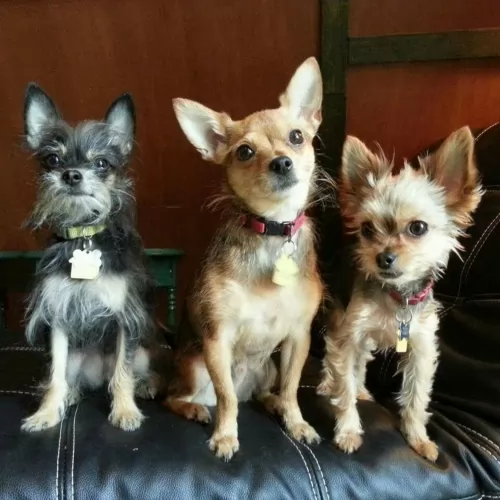 Petzlover
Petzlover Chorkie is originated from United States but Queensland Heeler is originated from Australia. Chorkie may grow 42 cm / 16 inches shorter than Queensland Heeler. Chorkie may weigh 13 kg / 28 pounds lesser than Queensland Heeler. Chorkie may live 3 years less than Queensland Heeler. Both Chorkie and Queensland Heeler has same litter size. Both Chorkie and Queensland Heeler requires Low Maintenance.
Chorkie is originated from United States but Queensland Heeler is originated from Australia. Chorkie may grow 42 cm / 16 inches shorter than Queensland Heeler. Chorkie may weigh 13 kg / 28 pounds lesser than Queensland Heeler. Chorkie may live 3 years less than Queensland Heeler. Both Chorkie and Queensland Heeler has same litter size. Both Chorkie and Queensland Heeler requires Low Maintenance.
 The Chorkie is a very popular little dog but he is not a purebred. The Chorkie was developed by crossing the Yorkshire Terrier with the Chihuahua. Probably the most popular Chorkie ever was the Taco Bell dog in the 1990s. This hybrid is a young breed created in the late 1900’s. These small, toy dogs are great lapdogs. It’s not possible to know the exact heritage of the Chorkies but the initial crossing of the two breeds occurred in the early part of the 20th century.
The Chorkie is a very popular little dog but he is not a purebred. The Chorkie was developed by crossing the Yorkshire Terrier with the Chihuahua. Probably the most popular Chorkie ever was the Taco Bell dog in the 1990s. This hybrid is a young breed created in the late 1900’s. These small, toy dogs are great lapdogs. It’s not possible to know the exact heritage of the Chorkies but the initial crossing of the two breeds occurred in the early part of the 20th century.
The Chorkie makes a great indoor pet best suited for the single or elderly person. Not because the Chorkie does not like children but because they are so small they can be easily injured by children. They are continuing to grow in popularity all the time among those who enjoy the new designer dogs.
 Another name for Queensland Heeler is Australian Cattle Dog or Blue Heeler.
Another name for Queensland Heeler is Australian Cattle Dog or Blue Heeler.
These dogs have always been known for herding cattle. The term ‘Heeler’ comes from the dog’s working style – nipping and biting at the cattle’s hooves.
He was was an Australian cattle dog for Australian settlers in the 1800s. It is believed that Thomas Hall created one of the foundations of the Australian Cattle Dog breed by crossing crossing sheepdogs with Dingos.
The Blue-colored dogs have been the most popular, being known as the Blue Heeler.
 As mentioned previously the Chorkie is a mix between the Yorkshire Terrier (Yorkie) and the Chihuahua. They Tend to look more like the terrier than the Chi with a small head carried high on a well-proportioned body, with the long silky hair of the Yorkie. Their head carried the shape of the Chihuahua. Like the Chihuahua, they have mostly pointed ears although some Chorkies have droopy ears. The Chorkie coat is silky, long, and can be in a variety of colors. The ears are either fringed like the Yorkie or smooth like the Chihuahua.
As mentioned previously the Chorkie is a mix between the Yorkshire Terrier (Yorkie) and the Chihuahua. They Tend to look more like the terrier than the Chi with a small head carried high on a well-proportioned body, with the long silky hair of the Yorkie. Their head carried the shape of the Chihuahua. Like the Chihuahua, they have mostly pointed ears although some Chorkies have droopy ears. The Chorkie coat is silky, long, and can be in a variety of colors. The ears are either fringed like the Yorkie or smooth like the Chihuahua.
 The Queensland Heeler is a medium sized dog that stands between 43 and 51cm in height, both male and female. The dog weighs in the region of 15 to 22kg.
The Queensland Heeler is a medium sized dog that stands between 43 and 51cm in height, both male and female. The dog weighs in the region of 15 to 22kg.
He has a short double coat with colors being blue, mottled blue and also red speckled. You’ll also find black and tan coloring on this active dog.
He is strong, lean and muscular with medium sized ears that are erect. The eyes are dark and alert, the legs straight and strong. The tail can be docked or left long.
The Australian Cattle Dog is a high-energy working dog that you won’t easily find lying around. The alert eyes are consistently looking around for action and he can’t be bored otherwise he could resort to digging or other destructive behavior.
He is loving to his entire human family, but being particularly attached to just one family member. He is also protective, taking his guarding role of his family seriously.
He gets on well with children and other pets but you’ve just got to keep your eyes on him around children as when excited he can give a nip or two.
Training and socialization will be important for this dog, particularly because he can be strong-headed, willful and stubborn.
 Remember that the Chorkie is a cross breed and not a purebred. Its temperament is that of a mixed breed dog which is usually laid back and mellow. The Chorkie might bark a lot as both the Yorkshire and the Chihuahua are known to bark. It can carry the traits of either or both of its parents.
Remember that the Chorkie is a cross breed and not a purebred. Its temperament is that of a mixed breed dog which is usually laid back and mellow. The Chorkie might bark a lot as both the Yorkshire and the Chihuahua are known to bark. It can carry the traits of either or both of its parents.
The Chorkie is a great lap dog though he can be stubborn and wear their owner out with all their energy. They are playful and willful and need strong leadership despite their small size. They will bark at anything they find to be suspicious. Despite their size they are highly intelligent and very loyal, affectionate dogs. They love their people and will not like it if you leave them alone very often. They are quite brave to the point of being reckless and can be aggressive toward dogs a lot bigger than they are. Due to their courage and their barking they are great family dogs.
 Active, intelligent, feisty, brave, playful, loving – these are just some of the wonderful characteristics you get when you bring a Queensland Heeler into your home.
Active, intelligent, feisty, brave, playful, loving – these are just some of the wonderful characteristics you get when you bring a Queensland Heeler into your home.
True, he is independent, self-willed and stubborn, but training and socialization can take away all the rough edges.
He forms a strong bond with his human owner, and once you’ve had one of these amazing dogs in your life, you’ll be convinced that dogs are truly man’s best friend.
 Australian Cattle Dogs are healthy. Every dog, even the most healthiest breeds, can succumb to some of the common dog illnesses there are.
Australian Cattle Dogs are healthy. Every dog, even the most healthiest breeds, can succumb to some of the common dog illnesses there are.
This is an inherited condition, so if you’re looking for a puppy, be careful about the breeder you buy from.
This is another inherited condition where the thighbone of the dog doesn't fit properly into the hip joint. Your dog is usually so active but with this problem he may well be in pain and actually be lame. Your pet can even develop arthritis . The idea is to get your pet to the vet because it can be unbearable to see him in pain and unable to get around.
This eye disease can mean deterioration of the retina. You'll recognize the signs when you see your dog unable to navigate around your home during the night. He is night blind but later on he can’t see during the day either.
 These small dogs have a lot of energy and need to eat a food that is high in quality calories. No empty calories for these guys. Feed them at least twice a day and no more than a fourth of a cup of dry food for the entire day. They can become overweight easily so do not overfeed.
These small dogs have a lot of energy and need to eat a food that is high in quality calories. No empty calories for these guys. Feed them at least twice a day and no more than a fourth of a cup of dry food for the entire day. They can become overweight easily so do not overfeed.
Additional health issues might include knee cap dislocation leading to arthritis or lameness and a tendency to develop low blood sugar.
Again, these are high energy little dogs. They need to be exercised or at least have brisk play inside the house. They excel at competitive games such as barn hunt, agility and obedience.
 To cope with his life on the Australian Outback, the Queensland Heeler is known to be a low maintenance dog.
To cope with his life on the Australian Outback, the Queensland Heeler is known to be a low maintenance dog.
The thick coat does shed and it can get dusty so a good brush twice a week is all that is basically required for this dog. If his nails don’t wear down naturally, you will need to have them trimmed. As with every dog, you will need to give attention to his ears and teeth.
This is an extremely active dog. He is going to be needing both mental and physical stimulation to avoid boredom, after all he is used to an active lifestyle herding cattle. Hikes, swimming, running – you name it – he’ll join you with all your activities.
Your Queensland Heeler is such a vibrant dog, full of the joys of living, and you want to ensure he has good food to eat to ensure he stays like that.
For convenience you get some excellent commercially manufactured dog foods. Your Blue Heeler is such a wonderful companion dog that you want to spoil him a bit and give him some delicious home-made food too. Boiled chicken, brown rice or pasta and spinach, sweet potatoes and carrots are a healthy choice for your pet – plain and simple just like dogs love it. Chop it up and add it into the high quality dry kibble a couple of times a week.
Some raw meat added in from time to time will help his skin and coat remain healthy. Never leave him without a constant source of fresh, cool water.